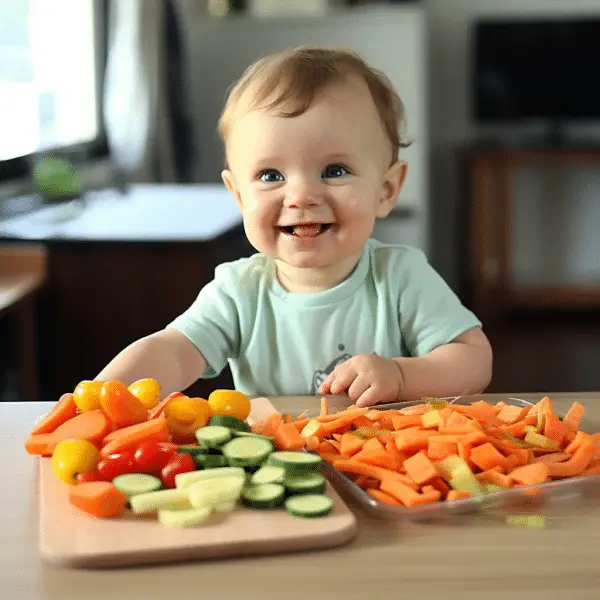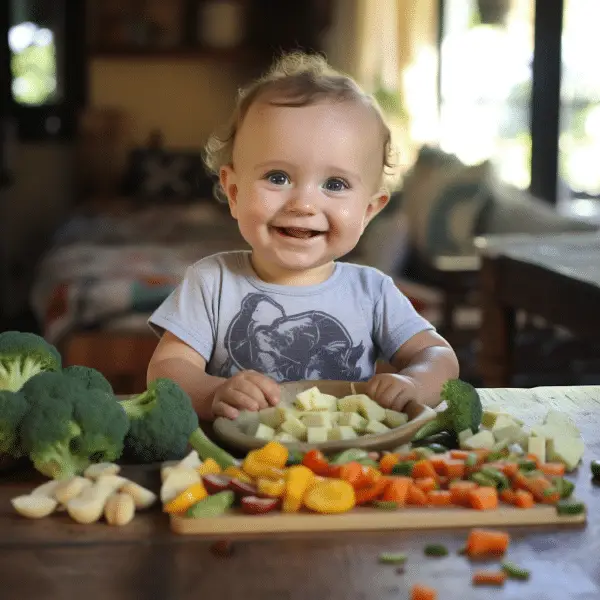Exploring Baby-Led Weaning: Fostering Healthy Eating Habits
Welcome to my article on Baby-Led Weaning! If you’re a parent looking for a gentle and enjoyable way to introduce your baby to solid foods, then you’ve come to the right place. Baby-Led Weaning is a feeding approach that allows infants to feed themselves right from the start, promoting independence and healthy eating habits. By offering soft finger-sized pieces of food that the baby can hold and squish, Baby-Led Weaning reduces the risk of choking and encourages exploration of different tastes and textures.
Key Takeaways:
- Baby-Led Weaning is a method that allows infants to self-feed right from the start.
- Soft finger-sized pieces of food are offered to reduce the risk of choking.
- Baby-Led Weaning promotes independence and healthy eating habits.
- It is important to prioritize safety and observe your baby’s developmental milestones.
- Always consult with a healthcare professional for personalized guidance and support.

What is Baby-Led Weaning?
Baby-Led Weaning (BLW) is a popular approach to introducing solid foods to infants that emphasizes self-feeding. Instead of spoon-feeding purees, parents offer soft finger-sized pieces of food that the baby can hold and explore on their own. This method allows the baby to control their own eating and develop essential motor and sensory skills. BLW is a gentle and enjoyable way to introduce your baby to solid foods while promoting independence and healthy eating habits.
With Baby-Led Weaning, infants are given the opportunity to engage with food in a more hands-on way. They can explore the different textures, shapes, and tastes of the food, which helps develop their oral motor skills and hand-eye coordination. This approach also encourages babies to listen to their own hunger and fullness cues, leading to a healthier relationship with food as they grow.
“Baby-Led Weaning is not just about introducing solid foods; it’s about fostering a positive and healthy relationship with food right from the start.”
It’s important to note that Baby-Led Weaning is not a replacement for breastfeeding or formula feeding. Breast milk or formula should still be the primary source of nutrition for babies under one year old, with solid foods being introduced gradually alongside milk feeds. Baby-Led Weaning simply offers a different way of introducing solid foods that can be a valuable addition to a baby’s feeding journey.
| Benefits of Baby-Led Weaning | When to Start Baby-Led Weaning |
|---|---|
| – Promotes independence and self-regulation of food intake | – Typically around 6 months of age |
| – Encourages healthy eating habits | – When the baby has doubled their birth weight and can sit up well |
| – Develops fine motor skills and hand-eye coordination | – Shows an interest in food and can move food around in their mouth |
| – Fosters family mealtime participation | – Should consult with a healthcare provider before introducing solids |
Baby-Led Weaning is a flexible approach that can be adapted to suit the needs of each individual baby and family. It’s important to remember that every baby is unique, and their readiness for solid foods may vary. Consulting with a healthcare provider can provide personalized guidance and support as you navigate the exciting world of introducing solids to your little one.
Benefits of Baby-Led Weaning
Baby-Led Weaning offers several benefits that make it a popular choice for introducing solids to your baby. One of the key advantages is that it allows your baby to explore a wide variety of tastes and textures right from the start. By offering soft finger-sized pieces of food, your baby can experience different flavors and develop a diverse palate, which can contribute to a lifetime of healthy eating habits. This approach also encourages independent eating, as your baby has control over their own food intake and can learn to self-regulate their hunger and fullness cues.
Another benefit of Baby-Led Weaning is that it promotes family mealtime participation. By including your baby in the family meal, you create a positive eating environment and encourage social interaction. This can have a positive impact on their overall eating habits and behavior around food. Additionally, Baby-Led Weaning can help develop fine motor skills, hand-eye coordination, and oral motor skills as your baby grasps, manipulates, and chews on different foods.
Benefits of Baby-Led Weaning:
- Promotes exploration of tastes and textures
- Encourages independent eating and self-regulation
- Fosters healthy eating habits and diverse palate
- Promotes family mealtime participation and social interaction
- Develops fine motor skills, hand-eye coordination, and oral motor skills
“Baby-Led Weaning provides an opportunity for babies to develop a positive relationship with food and learn to enjoy a wide variety of flavors early on. By allowing them to explore and participate in mealtime, we are setting the foundation for healthy eating habits and positive attitudes towards food.” – Dr. Sarah Johnson, Pediatric Nutritionist
Overall, Baby-Led Weaning offers numerous benefits for both babies and parents. From promoting independence and healthy eating habits to developing essential skills, this approach can be a gentle and enjoyable way to introduce your baby to solid foods. Remember to always prioritize safety, stay attentive during mealtime, and consult with a healthcare professional for personalized guidance based on your baby’s individual needs and development.
| Benefits of Baby-Led Weaning |
|---|
| Promotes exploration of tastes and textures |
| Encourages independent eating and self-regulation |
| Fosters healthy eating habits and diverse palate |
| Promotes family mealtime participation and social interaction |
| Develops fine motor skills, hand-eye coordination, and oral motor skills |
When to Start Baby-Led Weaning
Baby-Led Weaning is recommended by the American Academy of Pediatrics as a suitable method for introducing solid foods to infants. The age at which to start Baby-Led Weaning may vary slightly based on individual development, but typically, babies are ready to begin around 6 months of age. It’s important to look for certain signs of readiness before starting this approach.
According to the American Academy of Pediatrics, babies need to have doubled their birth weight, be able to hold their head up steadily, show an interest in food, and have the ability to move food around in their mouths. These milestones indicate that a baby has the necessary physical and oral motor skills to handle solid foods.
Before starting Baby-Led Weaning, it’s essential to consult with a healthcare provider to ensure your baby is developmentally ready and to address any concerns or questions you may have. Each baby is unique, and a healthcare professional can provide personalized guidance based on your baby’s specific needs and developmental progress.
By starting Baby-Led Weaning at the appropriate age, you can provide your baby with a safe and enjoyable introduction to solid foods, fostering their independence and encouraging healthy eating habits from the beginning.
How to Start Baby-Led Weaning
When starting Baby-Led Weaning, it’s important to ensure that your baby is developmentally ready and can sit up with support. To begin, offer soft finger-sized pieces of food that are easy for the baby to hold and explore. It’s best to start with one food at a time and gradually introduce a variety of tastes and textures to your baby’s diet. During mealtime, it’s crucial to closely watch your baby and allow them to take the lead in terms of how much and what they eat.
One helpful tip is to offer a range of nutritious first foods that are appropriate for your baby’s age and stage of development. Soft fruits and vegetables, such as banana, avocado, and steamed sweet potato, are great options to start with. These foods should be cut into finger-sized pieces that are easy for your baby to handle and chew.
Additionally, remember that Baby-Led Weaning is a process of exploration and learning for your baby. It’s normal for them to gag at times as they navigate different textures and learn how to chew and swallow. Gagging is actually a natural reflex that helps prevent choking, so it’s important not to panic if it occurs. However, it’s crucial to educate yourself on the difference between gagging and choking, and know how to respond appropriately in case of an emergency.
| Foods to Start with | Age Recommendation |
|---|---|
| Soft cooked carrot sticks | 6-8 months |
| Avocado slices | 6-8 months |
| Ripe banana pieces | 6-8 months |
| Steamed broccoli florets | 8-10 months |
| Soft cooked pasta spirals | 8-10 months |
Remember, every baby is unique, and it’s important to follow their cues and preferences when it comes to Baby-Led Weaning. Offer a variety of foods, textures, and flavors to help them develop a diverse palate, and always prioritize their safety during mealtime.
Best Starter Foods for Baby-Led Weaning
When starting Baby-Led Weaning, it’s important to choose appropriate first foods that are easy for your baby to handle and chew. Here are some great starter foods to consider:
- Soft fruits: Offer sliced or mashed banana, ripe avocado, or steamed pear.
- Cooked vegetables: Try steamed sweet potato wedges, roasted carrot sticks, or mashed butternut squash.
- Soft proteins: Consider offering well-cooked and shredded chicken or beef.
- Whole grains: Introduce cooked quinoa, small pasta shapes, or rice cakes.
- Eggs: Make sure eggs are fully cooked and offer scrambled eggs or omelets in small pieces.
Remember to cut all foods into finger-sized pieces or strips that are easy for your baby to hold and chew. The goal is to provide a variety of flavors and textures to help them explore different tastes and develop their chewing skills.
Sample Table: Nutritional Value of Starter Foods
Here is a table showcasing the nutritional value of some common starter foods for Baby-Led Weaning:
| Food | Calories | Protein (g) | Fat (g) | Carbohydrates (g) | Fiber (g) | Vitamin C (mg) |
|---|---|---|---|---|---|---|
| Banana (1 medium) | 96 | 1.2 | 0.3 | 23.5 | 2.6 | 10.3 |
| Avocado (1/2 medium) | 120 | 1.4 | 10.5 | 6.7 | 5.4 | 6.0 |
| Sweet Potato (1/2 cup) | 90 | 2.1 | 0.1 | 21.0 | 3.3 | 22.3 |
| Chicken (1 ounce) | 55 | 8.0 | 2.3 | 0.0 | 0.0 | 0.2 |
| Quinoa (1/2 cup cooked) | 111 | 4.0 | 2.0 | 20.2 | 2.6 | 0.0 |
These values are approximate and can vary depending on the size and preparation method of the food. Always consult with a healthcare professional for individualized guidance on your baby’s nutritional needs.
Safety Tips for Baby-Led Weaning
When it comes to practicing Baby-Led Weaning, ensuring a safe feeding environment is of utmost importance. Here are some key safety tips to keep in mind:
1. Supervise Closely
It’s essential to closely supervise your baby during mealtime when practicing Baby-Led Weaning. This means staying within arm’s reach and paying full attention to your baby’s eating behaviors. By doing so, you can quickly respond if any choking or gagging occurs.
2. Avoid Choking Hazards
Certain foods can pose a choking hazard for babies. It’s crucial to avoid giving your baby foods such as whole grapes, popcorn, or any small, hard foods that they might not be able to chew or swallow properly. Additionally, be cautious of foods with tough skins or seeds that could become lodged in your baby’s throat.
3. Cut Food Appropriately
When offering foods for Baby-Led Weaning, it’s important to cut them into appropriate sizes that are easy for your baby to handle. This helps reduce the risk of choking and ensures that the food is manageable for your baby to chew and swallow. Aim for finger-sized pieces that your baby can easily grasp and manipulate.
Remember, every baby is different, and it’s crucial to be prepared and informed about choking prevention techniques. Taking a CPR course can provide you with the knowledge and confidence to respond effectively in case of an emergency. By following these safety tips, you can create a secure environment for your baby to explore self-feeding and enjoy their journey with solid foods.
Baby-Led Weaning and Choking
One common concern parents have about Baby-Led Weaning is the potential increased risk of choking. However, research shows that gagging is a normal part of the self-feeding process and does not necessarily lead to choking. Gagging is actually the body’s natural reflex to prevent choking and is an important skill for babies to develop as they explore different foods.
It’s important for parents to distinguish between gagging and choking. Gagging is when the baby reflexively pushes food forward with their tongue and may make retching or coughing sounds. This is a normal response and should not cause alarm. Choking, on the other hand, is when the airway becomes partially or completely blocked and the baby is unable to breathe. It requires immediate intervention.
When practicing Baby-Led Weaning, it’s crucial for parents to closely supervise their baby during mealtime and be prepared to respond if choking occurs. Knowing the signs of choking and being trained in infant CPR can provide parents with the confidence and ability to act quickly in an emergency situation. Remember, a baby who is choking may be unable to make sounds, cough, or breathe, and their face may turn red or blue.
The Role of Teeth in Baby-Led Weaning
When it comes to Baby-Led Weaning, many parents wonder about the role of teeth. Contrary to popular belief, babies do not need teeth to practice self-feeding. Their gums are strong enough to mash and chew soft finger foods. As they continue to explore different textures and practice chewing, the eruption of teeth will further enhance their chewing skills.
Introducing a variety of textures is crucial to help babies develop their chewing skills. Soft fruits and vegetables, such as banana, avocado, steamed sweet potato, and roasted apple wedges, are excellent starter foods for Baby-Led Weaning. These foods can be cut into finger-sized pieces that are easy for the baby to handle and chew.
Table: Foods for Developing Chewing Skills in Baby-Led Weaning
| Food | Description |
|---|---|
| Banana | Soft and easy to chew |
| Avocado | Nutrient-rich and creamy |
| Steamed sweet potato | Soft and naturally sweet |
| Roasted apple wedges | Tender and flavorful |
Through Baby-Led Weaning, babies gradually learn to manipulate food in their mouths, even without teeth. As they chew and explore different tastes and textures, their eating abilities will naturally develop. It’s important for parents to provide a variety of foods to help babies build strong chewing skills, regardless of whether they have teeth or not.
Combining Baby-Led Weaning and Purees
Combining Baby-Led Weaning and purees can provide a flexible and varied approach to introducing solid foods to your baby. This approach allows you to incorporate both self-feeding and spoon-feeding methods, based on your baby’s needs and preferences. It’s important to follow your baby’s cues and introduce new foods gradually to ensure a positive feeding experience.
Advantages of combining Baby-Led Weaning and purees:
- Gradual introduction: Purees can be used in the beginning to help your baby get used to the taste and texture of solid foods.
- Smooth texture: Purees provide a smoother consistency that can be easier for some babies to manage, especially when starting solids.
- Increased variety: Combining Baby-Led Weaning and purees allows you to offer a wider range of flavors and textures to your baby.
When incorporating purees, it’s important to offer them alongside finger foods to encourage self-feeding and the development of fine motor skills. You can offer purees on a spoon or allow your baby to explore them using their hands. Remember that the goal is to gradually transition to self-feeding, so continue to offer finger-sized pieces of food alongside purees as your baby becomes more comfortable and skilled with feeding themselves.
“Combining Baby-Led Weaning and purees can provide the best of both worlds, allowing your baby to explore and experiment with different foods while still providing the convenience and familiarity of purees.” – Pediatric Nutritionist
Keep in mind that every baby is unique, and their readiness and preferences for self-feeding may vary. Some babies may prefer to self-feed exclusively, while others may prefer a mix of self-feeding and spoon-feeding. The key is to be flexible and responsive to your baby’s cues and individual needs. Consulting with a healthcare professional can provide personalized guidance and support as you navigate the combination of Baby-Led Weaning and purees for your baby.
| Pros of Combining Baby-Led Weaning and Purees | Cons of Combining Baby-Led Weaning and Purees |
|---|---|
|
|
Frequently Asked Questions about Baby-Led Weaning
Baby-Led Weaning can raise several questions for parents. Here are some common FAQs along with answers to help you navigate this feeding approach:
1. Is Baby-Led Weaning safe?
Baby-Led Weaning can be a safe way to introduce solid foods, as long as certain precautions are taken. It’s important to create a safe feeding environment, supervise your baby closely during mealtime, and offer appropriate finger foods that are easy for them to handle. Additionally, it’s crucial to learn the difference between gagging and choking, and know how to respond in case of an emergency. Consulting with a healthcare professional can provide personalized guidance and help address any safety concerns you may have.
2. How do I prevent choking during Baby-Led Weaning?
While gagging is a normal part of the self-feeding process, there are steps you can take to reduce the risk of choking. Avoid offering foods that pose a choking hazard, such as whole grapes or popcorn. Cut foods into appropriate sizes and shapes that are easy for your baby to handle and chew. It’s also important to educate yourself on the signs of choking and be prepared to respond quickly if it occurs. Learning CPR can provide you with valuable skills in case of an emergency.
3. Can I introduce allergenic foods through Baby-Led Weaning?
Baby-Led Weaning can be a great opportunity to introduce allergenic foods to your baby. In fact, research suggests that early introduction of potential allergens, such as peanut butter and eggs, may actually reduce the risk of allergies. However, it’s important to discuss your family’s history of allergies with a healthcare professional before introducing allergenic foods. They can guide you on how to safely introduce these foods and monitor for any allergic reactions.
| Question | Answer |
|---|---|
| Is Baby-Led Weaning safe? | Baby-Led Weaning can be a safe way to introduce solid foods, as long as certain precautions are taken. It’s important to create a safe feeding environment… |
| How do I prevent choking during Baby-Led Weaning? | While gagging is a normal part of the self-feeding process, there are steps you can take to reduce the risk of choking…. |
| Can I introduce allergenic foods through Baby-Led Weaning? | Baby-Led Weaning can be a great opportunity to introduce allergenic foods to your baby. In fact, research suggests that early introduction of potential allergens… |
Conclusion
Baby-Led Weaning is a gentle and effective approach to introducing your baby to solid foods. By allowing babies to self-feed and explore a variety of tastes and textures, this method promotes independent eating and healthy habits. It is important to prioritize safety, offer appropriate finger foods, and follow your baby’s cues and developmental milestones.
Remember, consulting with a healthcare professional for personalized guidance and support throughout your baby’s feeding journey is essential. They can provide valuable insight and address any concerns you may have, including questions about choking, portion sizes, introducing allergenic foods, and the role of breast milk or formula in your baby’s diet.
As you embark on this exciting stage of your baby’s development, enjoy the journey of watching them discover new flavors and textures. Baby-Led Weaning can be a delightful and bonding experience for both you and your little one. Embrace the joy of independent eating and nourish your baby’s growing appetite in a safe and nurturing way.
FAQ
When can I start Baby-Led Weaning?
Babies are typically ready to start Baby-Led Weaning around 6 months of age, when they have doubled their birth weight, can hold their head up well, show an interest in food, and are able to move food around in their mouths. However, it’s important to consult with a healthcare provider and observe your baby’s developmental milestones before introducing solid foods.
What foods should I offer for Baby-Led Weaning?
Good starter foods for Baby-Led Weaning include soft fruits and vegetables such as banana, avocado, steamed sweet potato, and roasted apple wedges. These foods should be cut into finger-sized pieces that are easy for the baby to hold and chew. It’s important to offer a variety of flavors and textures to expose the baby to different tastes and help them develop a diverse palate.
Is Baby-Led Weaning safe? What about choking?
Baby-Led Weaning can be safe when proper precautions are taken. It’s important to supervise the baby closely during mealtime, avoid foods that pose a choking hazard such as whole grapes or popcorn, and cut foods into appropriate sizes that are easy for the baby to handle. It’s also crucial to learn the difference between gagging and choking and be prepared to respond with CPR if needed. Research shows that gagging is a normal part of the self-feeding process and does not necessarily lead to choking.
Can I combine Baby-Led Weaning and purees?
Yes, Baby-Led Weaning and purees are not mutually exclusive. Many parents choose to combine both approaches, offering soft finger foods for the baby to explore and also providing purees for a smoother texture or when introducing specific foods. It’s important to follow the baby’s cues and preferences when determining the best approach for your family.
What if my baby doesn’t have teeth?
Babies do not need teeth to practice Baby-Led Weaning. Gums are strong enough for the baby to mash and chew soft finger foods. As the baby continues to explore different textures and practice chewing, their eating abilities will naturally develop. The eruption of teeth will further enhance their chewing skills.
How can I ensure my baby is getting enough nutrition with Baby-Led Weaning?
Breast milk or formula should continue to be the primary source of nutrition for babies up until the age of 1. Baby-Led Weaning is a complementary approach to solid foods and should not replace breast milk or formula. As the baby explores and eats more solid foods, they will gradually transition to a wider variety of nutrients. It’s important to consult with a healthcare professional for personalized guidance and support.







